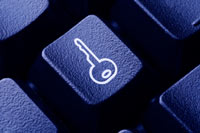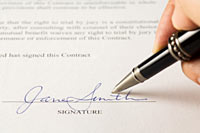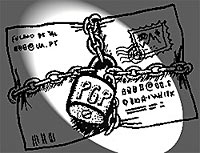|
Keeping it Real
For the longest time, I scoffed at the idea of
the paperless office. Never thought it'd live up to
all the hype. I liked the permanence and "security"
of paper checks and statements and records. Well,
the world is definitely changing. Most of us have
become much more comfortable with online services,
banking, electronic records and billing, and
important documents attached to email. More and
more, people are doing business over the Internet.
The need to exchange signed paper documents has been
a drag on commerce, so clever strategies have been
developed to verify an electronic document is
original, genuine, and authorized.
This is the final installment in the "Keeping
Secrets" article series. Here are links for
Part One and
Part Two and
Part Three.
Even if you're not all that interested in
securing your documents and communications, there's
another aspect to public key cryptography that'll
likely be a very important part of doing business in
the near future: digital signatures and
authentication.
Before we go too much further, I should remind you
that I'm far from an expert on this topic. The
waters get deep very fast. People get Ph.D.'s in
this stuff. Multiple Ph.D.'s actually. I'm just a
guy who understands the common business applications
and does a (hopefully) decent job of explaining the
essentials to other businesspeople. So if you,
Doctor Doctor Cryptanalyst are reading this, please
don't write to me that I said XYZ, when it's really
WXYZ. I know. But there was no time to do the W
stuff!
 What
makes digital signatures so much better than an ink
pen on paper? Well that blue ink squiggle on the
paper document you just received in your postal
mailbox may belong to the other person you're doing
the deal with… or it may not. Only a forensic
handwriting expert could tell for sure. Even then,
how would you know if somebody altered the document
after it was signed? Or if whole pages were added or
deleted? What
makes digital signatures so much better than an ink
pen on paper? Well that blue ink squiggle on the
paper document you just received in your postal
mailbox may belong to the other person you're doing
the deal with… or it may not. Only a forensic
handwriting expert could tell for sure. Even then,
how would you know if somebody altered the document
after it was signed? Or if whole pages were added or
deleted?
A digital signature on the other hand will ensure
the document came from the right person (and nobody
else), that it has not been altered in any way
whatsoever, and if it's encrypted too, that no other
person has been able to intercept and read it in
transit.
Here's how it works. Do you remember what I said
about public key cryptosystems? If you want to send
a secret message to someone, you look up their
openly published public key and use that key to
encode your document. Once you've done that, only
your recipient's corresponding private key can
decrypt the message.
Now, what would happen if instead you used your
private key to encrypt the document? Well, in that
case, ONLY your published public key could unlock
it. PGP software automates all of this.
 However,
it's actually not necessary to encrypt your whole
document in order to prove it came from you and you
alone. Instead, we use something called a one-way
hash function to crunch your original document or
file down to a very small unique item called a
message digest. PGP takes this digest and binds it
to your public key. However,
it's actually not necessary to encrypt your whole
document in order to prove it came from you and you
alone. Instead, we use something called a one-way
hash function to crunch your original document or
file down to a very small unique item called a
message digest. PGP takes this digest and binds it
to your public key.
There's no way for a wrong-doer to detach your
digital sig from one document and attach it to
another. Also, the slightest change to the original
document file will generate a totally different
message digest -- and the received file will be
flagged as altered.
Does all this sound too complicated? Even if it
does, that shouldn't bother you too much. The PGP
software does all the heavy lifting for you. You
don't have to know what's happening behind the
curtain.
We'll that's it. It's time for me to bring this very
high altitude flight over the world of encryption in
for a landing. Next month we'll depart for a totally
different destination.
Return to Archive
|

 What
makes digital signatures so much better than an ink
pen on paper? Well that blue ink squiggle on the
paper document you just received in your postal
mailbox may belong to the other person you're doing
the deal with… or it may not. Only a forensic
handwriting expert could tell for sure. Even then,
how would you know if somebody altered the document
after it was signed? Or if whole pages were added or
deleted?
What
makes digital signatures so much better than an ink
pen on paper? Well that blue ink squiggle on the
paper document you just received in your postal
mailbox may belong to the other person you're doing
the deal with… or it may not. Only a forensic
handwriting expert could tell for sure. Even then,
how would you know if somebody altered the document
after it was signed? Or if whole pages were added or
deleted? However,
it's actually not necessary to encrypt your whole
document in order to prove it came from you and you
alone. Instead, we use something called a one-way
hash function to crunch your original document or
file down to a very small unique item called a
message digest. PGP takes this digest and binds it
to your public key.
However,
it's actually not necessary to encrypt your whole
document in order to prove it came from you and you
alone. Instead, we use something called a one-way
hash function to crunch your original document or
file down to a very small unique item called a
message digest. PGP takes this digest and binds it
to your public key.